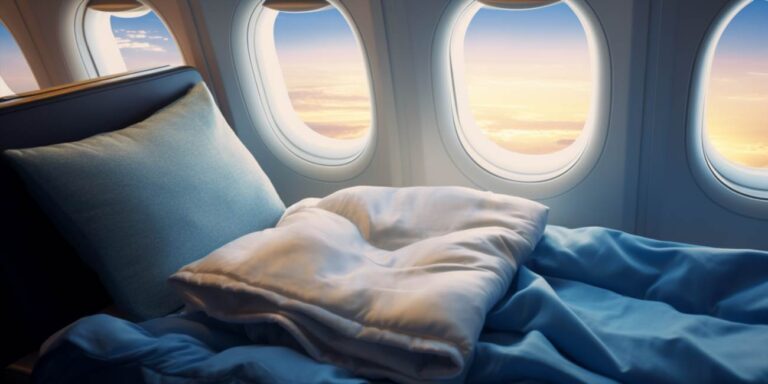Begin by arranging your travel pillow strategically. A neck pillow not only supports your head but can also be employed to provide lumbar support. Tuck it between your lower back and the seat for an added layer of comfort. This small addition can make a significant difference during a long-haul flight.
Next, consider the choice of blanket. While airlines typically provide thin blankets, bringing your travel blanket can enhance the warmth and comfort. Once you have your blanket, use it to create a barrier between you and the seat, adding an extra layer of cleanliness and coziness.
For additional comfort, the strategic use of extra clothing can work wonders. Instead of leaving your jacket hanging, repurpose it as a makeshift mattress pad. Fold it neatly and place it on the seat before covering it with your blanket. This ingenious hack provides extra cushioning for a more restful sleep.
Now, let’s talk about the legroom. Utilize the space under the seat in front of you by stowing away your carry-on luggage strategically. This creates more room for your legs to stretch out, making the sleeping arrangement on a plane feel less constricted.
For those who seek the utmost in-flight luxury, consider investing in an inflatable travel pillow. These compact pillows can be easily inflated and placed against the plane window, creating a makeshift bed extension. It’s a game-changer for those who prioritize both comfort and creativity.
As you embark on your journey to master the art of making a bed on a plane, remember that a few simple additions and strategic arrangements can turn your seat into a sanctuary above the clouds. Experiment with these tips and discover the joy of snoozing comfortably amidst the turbulence.
Comfortable sleeping positions on an airplane seat for long flights using inflatable pillows
Long flights can be challenging, especially when it comes to finding a comfortable sleeping position in the cramped confines of an airplane seat. However, with a bit of creativity and the right accessories, such as inflatable pillows, you can turn your economy seat into a cozy haven for rest and relaxation.
One of the most effective sleeping positions on an airplane is the modified fetal position. This involves slightly reclining your seat and curling up on your side, resembling the fetal position. To enhance this posture, use an inflatable pillow to support your head and neck, preventing stiffness and discomfort during your journey.
For those who prefer lying back, the reclined seat snooze is a popular choice. Utilize your inflatable pillow to provide additional lumbar support, maintaining the natural curve of your spine. This not only aids in comfort but also minimizes the risk of waking up with an achy back after a long flight.
If you find it challenging to sleep while seated, the forward-leaning power nap might be your go-to position. In this stance, you lean forward, resting your head on an inflatable pillow placed on the tray table. This position not only allows for a quick nap but also avoids the discomfort of your head bobbing during light sleep.
Now, let’s delve into the specifics of using inflatable pillows to enhance these sleeping positions. When adopting the modified fetal position, inflate the pillow to a medium firmness to provide ample support for your head and neck. This helps maintain alignment and reduces strain on your spine.
For the reclined seat snooze, consider using an inflatable pillow with adjustable firmness. This allows you to customize the support based on your comfort preferences. A well-supported neck and lower back can make a significant difference in your overall sleeping experience.
When opting for the forward-leaning power nap, choose an inflatable pillow with a contoured design. This shape provides optimal support for your forehead, reducing pressure on your neck and promoting a more comfortable nap, even in the confined space of an airplane.
It’s important to note that the size and design of inflatable pillows vary. Look for compact options that are easy to inflate and deflate, allowing for hassle-free storage during the flight. Additionally, some inflatable pillows come with built-in neck support or extra cushioning, catering to different preferences.
Choosing the best inflatable travel pillow and blanket for sleeping upright on airplanes

When embarking on a journey, the choice of the right travel pillow can make the difference between a restful nap and a discomfort-filled flight. The quest for the ideal in-flight slumber companion often extends beyond just a pillow, with many opting for a combination of travel pillow and blanket for the ultimate airborne coziness.
One of the crucial factors to consider is ensuring that the travel pillow is designed for upright sleeping. While traditional neck pillows serve their purpose, a specifically crafted upright pillow takes the comfort to a whole new level. Look for designs that provide ample neck and head support, allowing you to maintain a relaxed and comfortable position during the entire journey.
Now, let’s not forget the significance of the accompanying blanket. An inflatable travel pillow and blanket combo ensures that you not only have the right support for your upper body but also the added warmth and coziness of a blanket. The inflatable feature adds the advantage of easy storage when not in use, making it a convenient choice for frequent travelers.
When assessing the options, prioritize materials that are not only cozy but also easy to clean. After all, a comfortable journey includes a clean and fresh sleep environment. Opt for pillows and blankets made from hypoallergenic and breathable fabrics, enhancing the overall relaxing experience.
For those who appreciate a touch of luxury even at 30,000 feet, consider specialized travel pillows that come with additional features. Some boast built-in neck massagers for the ultimate in-flight pampering, elevating your relaxing journey to new heights.
Now, let’s delve into the art of choosing the right size. A comfortable and cozy travel experience is closely tied to the dimensions of your chosen pillow and blanket. Ensure that the size complements your body and doesn’t hinder your upright sleep position. Think of it as a tailored suit for your travel comfort.
Tips and tricks for sleeping well on red-eye and overnight flights
Traveling on a red-eye or overnight flight can be a challenging endeavor, especially when it comes to getting quality sleep amidst the hustle and bustle of the cabin. However, with a few savvy tips and tricks, you can turn your journey into a relaxing and cozy experience that allows you to dream peacefully. Here’s your guide to achieving a restful slumber above the clouds.
One key strategy is to create a sleep-inducing environment within your airplane seat. Consider bringing a neck pillow and a soft blanket for added comfort. These familiar items can help signal to your body that it’s time to relax and unwind. Additionally, using a sleep mask and earplugs can help block out disturbances, creating a more cozy atmosphere conducive to a good night’s sleep.
Adjusting your schedule before the flight is crucial. Gradually shift your sleep pattern to align with the destination’s time zone, helping your body adjust more smoothly. This simple trick can significantly reduce the effects of jet lag, making it easier for you to relax and sleep during the red-eye journey.
Another trick is to choose the right seat. Opt for a window seat to rest your head against the cabin wall, providing additional support for a more comfortable and cozy sleep. Moreover, dreaming can be enhanced by using a neck pillow to avoid uncomfortable positions that might disrupt your peaceful dreams.
When it comes to your attire, wear comfortable clothing to enhance your ability to relax and sleep. Consider packing a pair of cozy socks to keep your feet warm, contributing to an overall comfortable and relaxing in-flight experience.
Cozy up with a good book or a calming playlist before attempting to sleep. Engaging in a relaxing activity can help signal to your body that it’s time to unwind, making it easier for you to fall asleep and dream peacefully during the red-eye journey.






